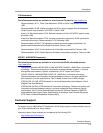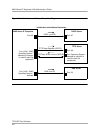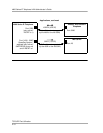
Overview of Voice over IP (VoIP)
SNMP
2-5
SNMP 2
Simple Network Management Protocol (SNMP) is a family of standards-based protocols and
procedures to allow vendor-independent data network management. Using a simple set of
protocol commands, an SNMP-compliant device stores information in standard format in one or
more Management Information Bases (MIBs). In general, devices support the standards-specific
MIB termed MIB-II. In addition, devices may define one or more “custom MIBs” that contain
information about the specifics of the device.
As of Release 1.1, the 4600 Series IP Telephones are fully compatible with SNMPv2c (a later
version of SNMP) and with Structure of Management Information Version 2 (SMIv2), although the
telephones will respond correctly to queries from entities that comply with earlier versions of
SNMP, such as SNMPv1. “Fully compatible” means that the telephones respond to queries
directed either at the MIB-II or the Custom MIB. The 4600 Series IP Telephone Custom MIB is
read-only (values therein cannot be changed externally via network management tools).
You can restrict which IP addresses the telephone accepts SNMP queries from and you can
customize your community string with system values SNMPADD and SNMPSTAT, respectively, as
indicated in Chapter 4
, Table 4-5.
More information about SNMP and MIBs can be found in the IETF references listed in Related
Documents, on page 1-6. The Avaya Custom MIB for the 4600 Series IP Telephones is available
for download in *.txt format on the Avaya support website.
Network Assessment 2
The current technology allows optimum network configurations to deliver VoIP with perceived
voice quality close to that of the Public Switched Telephone Network (PSTN). Not every network is
able to take advantage of packet voice transmissions. Some data networks have insufficient
residual capacity for even compressed voice traffic. In addition, the usual approach to developing
data networks by integrating products from many vendors makes it necessary to test the
components for compatibility with Voice over IP traffic.
It is assumed that your organization has performed a network assessment (with or without the
assistance of Avaya) before attempting to install Voice over IP, in order to have a high degree of
confidence that the existing data network has the capacity to carry voice packet traffic and is
compatible with the required technology.
A network assessment would include a determination of the following:
■ A network audit to review existing equipment and evaluate its capabilities, including its ability
to meet planned voice and data needs.
■ A determination of network objectives, including the dominant traffic type, choice of
technologies, and setting voice quality objectives.


















